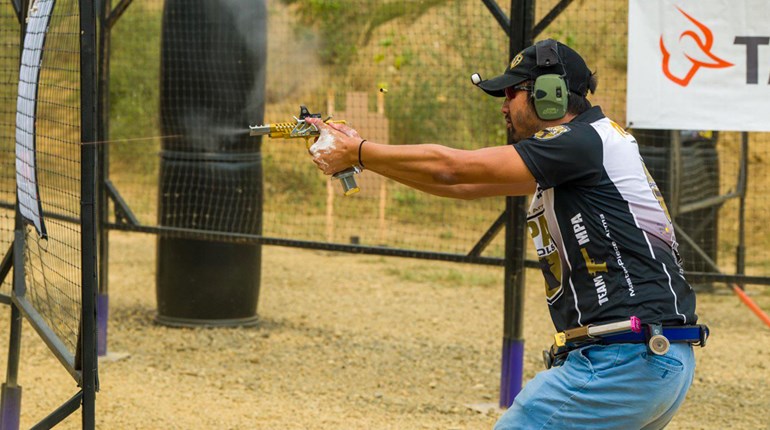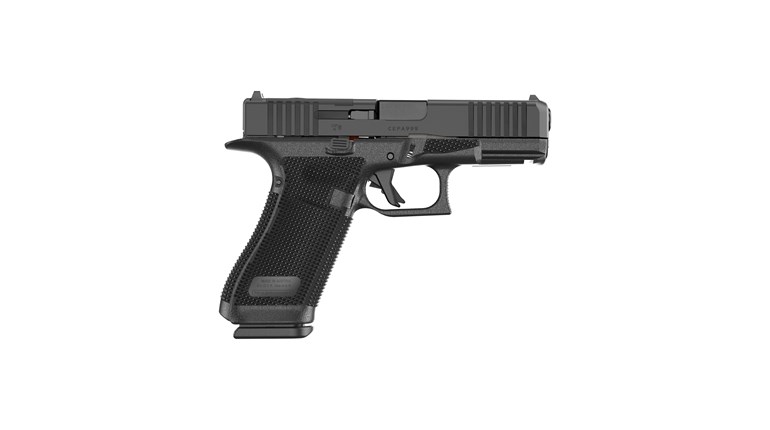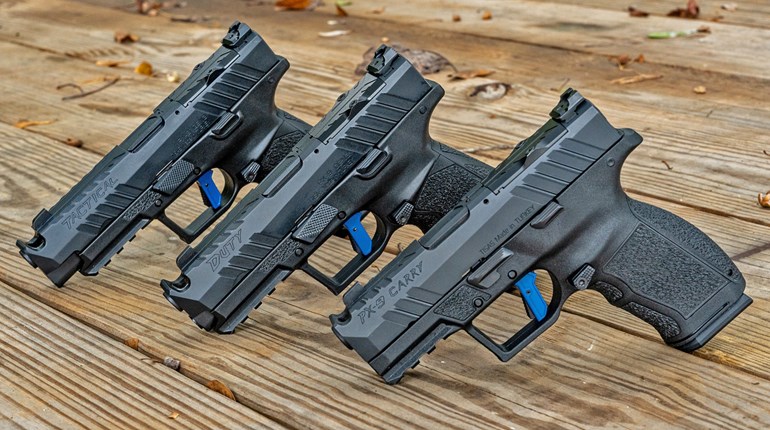
If you’ve an urge—admittedly perverse—to start a metaphorical (if not actual) fist fight, here’s a good bet: Assert that either the barrel/comp system or the sight is the “heart” of an Open Division handgun. If knowledgeable guys and gals are present, the game will, so to speak, be on.
Being more devout sorts of cowards, however, we flipped a coin in an undisclosed location, and it came up barrel/comp (granted, it’s a very unusual coin). So off we go.
We’ve talked about comps (short for compensator, here and here) before, though more often in the context of rifles. These are not actually new, unless you’re doing your counting in centuries: They grew commonplace particularly on large-bore guns—as in artillery—in the mid twentieth century. Expert will hear and immediately denounce us: “Those are/were ‘muzzle brakes,’ you quacks!” We concede the point, but offer our own in defense: What we’re talking about is the body of technologies that put propulsive gases to use in ways that reduce recoil, or at least channel it to help solve other problems. Whether it’s a “brake,” “comp,” some designs of flash suppressors or even Mag-na-port-style barrel porting, the lines grow blurry in a hurry.
Two inescapable conclusions emerge. First, they work. By redirecting gas from behind the projectile as it leaves the bore, they can harness powerful jets of said gases. If you trap these, or the vast bulk of them, you have a suppressor: Their wave front is what produces report in a firearm. If you redirect them against the upwards/rearwards rotational forces inherent in the perpetual argument between human ergonomics and the bore line of most firearms, voila! A comp is born.
Second: No, you can’t just slap any old combo of barrel, caliber and vented whatchamajigger together and expect to have a recoilless firearm. Remember, we’re redirecting that kinetic energy (in the form of high velocity gas), not doing away with it. Question for the physics wonks: What’s the reverse of a mushroom cloud, since this is what would appear if we were turning that energy back into matter, right? But we digress …

For our open project, the base pistol is a Glock G17. This is not, perhaps, as “convenient” or “mundane” a choice as it might seem. After long experimentation—some of it our own—9 mm has emerged as an excellent candidate for effective compensation for a combination of reasons. These are best thought of as a sort of balance between overall energy, available gas volume, bullet weight and diameter/caliber. Also, the workhorse G17 will require no permanent changes in our scheme: If you choose to follow along, you’ll wind up with (at least) two vastly different capacities in a single firearm. Aren’t you clever.
But 9 mm is the real key. Without sinking you in the science, it means the cartridge is well suited to generate enough gas to push the projectile at useful velocity while still activating the “porting” structures of the comp.
Implicit in this is why otherwise appealing cartridges don’t seem to respond as well to compensation. In the normal range of velocities and bullet weights, for instance, neither .40 S&W nor .45 ACP will activate comps very effectively. In these calibers, projectiles either need to be pushed faster (with more/faster powder), or their mass reduced. If you stay within the SAAMI parameters that won’t simply blow up or at least overwork cartridges (and your gun), compensation will work, but not nearly as effectively as in 9 mm. If you’re a little more dialed into this than the average bear, now you know why “long” 9 mm calibers like 9x21 or .38 Super were/are popular with Open division shooters: More case capacity and velocity equals more effective comp activation.
And that “activation” is the sometimes surprising name of the game. Remember, we aren’t eliminating recoil, just putting it to work in a very specifically advantageous way. Everybody is familiar with the up-and-back of normal handguns; even .22s do this to a small extent. Step up to .40 S&W or the likes of a .44 Remington Magnum, and the effect grows increasingly pronounced. Other than the Third Law effects that introduce issues of stature and technique, the big disadvantages are two-fold: Target obscuration by the lifting hand/wrist and firearm, and the need to realign the sights for any additional shots.
Comps for pistols don’t do much, generally speaking, for the “back” part of this problem (a very different story for rifles and up, and also where the fuzzy muzzle “brake” line can come back into play), nor can they, as the available gas budget is simply too tight. Most, then, have the majority of their ports/vents aligned to keep the muzzle down by venting gas upward. Clever, eh?
If you take a look at our Jager, you’ll see some additional “ah-ha!” has been embedded over the years—chambers. By “chambering” a port with the use of baffles (carefully angled walls within the comp), you gain the ability to create gas vectors in multiple directions. This allows you to essentially “time” the jets behind the departing bullet, and optimize the rise-suppression forces over the milliseconds the bullet acts as a valve in the successive baffles.
So how comps work baffles you no more? Bwahahahahaha. (If the editor leaves that in, we’ll be astonished.)
Naturally, a comp may not be attached to just any old barrel. For autoloaders especially, you need length in front of the slide for attachment. For our rig, we’ll be replacing the factory barrel with the match-grade Lone Wolf that Jager includes in their kit. We’ve plenty of experience here, as you may recall: The lads and lasses in Priest River have been getting it right for a loooooong time.

One last thing: We’re unapologetic about being partial to heavy bullets—even using up to 165-grain Xtremes in our competition loads. They’re soft shooting joys, and astonishingly easy on the ears: Out of PCCs, they are often mistaken for suppressed ammo/hardware. But these go by the boards for our Open set-up; as with virtually all others, they simply don’t have enough gas pressure/volume/velocity to activate the compensation dynamics, and quite often won’t even run the gun. 125s and below are where we’re headed.
By next time, we’ll have this spittin’ ‘em out, so stay tuned. Next up, a couple of sights take a ride on a fast-cycling slide.
Frank Winn has been studying arms and their relationship to tyranny, meaningful liberty and personal security all his adult life. He has been a firearms safety/shooting instructor for more than 20 years, and earned state, regional and national titles in several competitive disciplines.


































